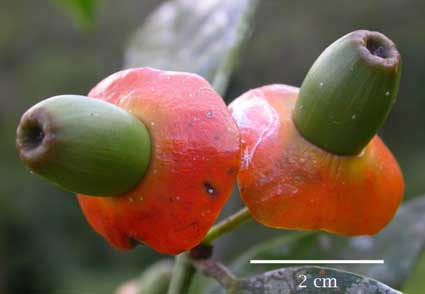Abstract
Heisteria austroecuadorica, a new species of Erythropalaceae from the conserved evergreen montane forest at the San Francisco reserve, in southeastern Ecuador, is here described and illustrated. It is characterized by the flowers with 10 stamens, and relatively large fruits, with the apex conspicuously depressed, and the calyx not covering the base of the fruits. Heisteria austroecuadorica is assessed provisionally as Endangered.
References
Anderson, W.R. (2007) Notes on Neotropical Malpighiaceae—IX. Contributions from the University of Michigan Herbarium 25: 95–111.
Arroyo, F., Pérez Castañeda, Á.J. & Vázquez García, J.A. (2013) Six new threatened tree species of Magnolia (Magnoliaceae) from Ecuador and Peru. 2. In: Salcedo Pérez, E., Hernández Álvarez, E., Vázquez García, J.A., Escoto García, T. & Díaz Echavarría, N. (eds.) Recursos Forestales en el Occidente de México. Universidad de Guadalajara, Guadalajara, pp. 497–508.
Bachman, S. & Moat, J. (2012) GeoCAT – An open source tool for Rapid Red List assessments. BGjournal 9: 11–13.
Berg, C.C. & Homeier, J. (2010) Three new species of South American Moraceae. Blumea 55: 196–200. https://doi.org/10.3767/000651910X527707
Cornejo, X. (2009) Meliosma longepedicellata (Sabiaceae): a new species from southeastern Ecuador. Harvard Papers in Botany 14: 93–96. https://doi.org/10.3100/025.014.0216
Duke, A. (1925) Plantes nouvelles ou peu connues de la région amazonienne (III). Archivos do Jardim Botânico do Rio de Janeiro 4: 9.
Engler, A. (1872) Olacinea. Flora Brasiliensis 12 (2): 18. Fleischer, Monachii & Lipsiae.
Haro-Carrión, X. & Robinson, H. (2008) A review of the genus Critoniopsis in Ecuador (Vernonieae: Asteraceae). Proceedings of the Biological Society of Washington 121 (1): 1–18. https://doi.org/10.2988/07-18.1
Homeier, J., Werner, F.A., Gradstein, S.R., Breckle, S.-W. & Richter, M. (2008) Potential vegetation and floristic composition of Andean forests in South Ecuador, with a focus on the RBSF. In: Beck, E., Bendix, J., Kottke, I., Makeschin, F. & Mosandl, R. (eds.) Gradients in a Tropical Mountain Ecosystem of Ecuador. Ecological Studies 198: 87–100. https://doi.org/10.1007/978-3-540-73526-7_10
Homeier, J., Breckle, S.W., Günter, S., Rollenbeck, R.T. & Leuschner, C. (2010) Tree diversity, forest structure and productivity along altitudinal and topographical gradients in a species-rich Ecuadorian montane tropical rain forest. Biotropica 42: 140–148. https://doi.org/10.1111/j.1744-7429.2009.00547.x
Humboldt, A. & Bonpland, A. (1809) Plantae Aequinoctiales Tomus secundus. F. Schoell, Paris, 191 pp.
IUCN Standards and Petitions Committee (2022) Guidelines for Using the IUCN Red List Categories and Criteria. Version 15. Prepared by the Standards and Petitions Committee. Available from: http://www.iucnredlist.org/documents/RedListGuidelines.pdf (accessed 1 July 2022).
Jackson, B.D. (1991) A Glossary of Botanic terms with their derivation and accent. 4th ed. London. Duckworth. 481 pp. https://doi.org/10.5962/bhl.title.6304
Jacquin, J.J. (1760) Enumeratio Systematica Plantarum, quas in insulis Caribaeis. Lugduni Batavorum (Leiden), Apud Theodorum Haak. https://doi.org/10.5962/bhl.title.100687
Jørgensen, P.M. & León, S. (eds.) (1999) Catalogue of the Vascular Plants of Ecuador. Monographs in Systematic Botany from the Missouri Botanical Garden 75: 1–118.
Jørgensen, P.M. & Ulloa Ulloa, C. (2002) Olacaceae. In: Harling, G. & Andersson, L. (eds.) Flora of Ecuador 69: 59–104.
Little, J.E.L. (1948) New species of trees from western Ecuador. Journal of the Washington Academy of Sciences 38 (3): 87–105.
Nickrent, D.L., Malécot, V., Vidal-Russell, R. & Der, J.P. (2010) A Revised classification of Santalales. Taxon 59: 538–558. https://doi.org/10.1002/tax.592019
Schneider, J.V. & Zizka, G. (2012) Quiina maracaensis J.V. Schneid. & Zizka and Quiina zamorensis J.V. Schneid. & Zizka (Quiinaceae), two new species of Quiina Aubl. from the Neotropics. Candollea 67: 261–267. https://doi.org/10.15553/c2012v672a7
Sleumer, H.O. (1938) Vermischte Diagnosen---VI. Repertorium Specierum Novarum Regni Vegetabilis 45: 9–20. https://doi.org/10.1002/fedr.19380450103
Sleumer, H.O. (1984) Olacaceae. Flora Neotropica 38: 1–159.
Standley, P.C. (1930) Studies of American Plants--IV. Publications of the Field Museum of Natural History, Botanical Series 8 (3): 131–236. https://doi.org/10.5962/bhl.title.2619
Stevens, P.F. (2001 onwards) Angiosperm Phylogeny Website. Available from: http://www.mobot.org/MOBOT/research/APweb/ (accessed 28 January 2023)
Thiers, B. (2023) Index Herbariorum: A global directory of public herbaria and associated staff. New York Botanical Garden’s Virtual Herbarium. Available from http://sweetgum.nybg.org/ih/ (accessed 1 March 2022).
Ulloa Ulloa, C. & Homeier, J. (2008) Meriania franciscana (Melastomataceae), una especie nueva de los Andes sur orientales del Ecuador. Anales del Jardín Botánico de Madrid 65: 383–387.
van der Werff, H. (2020) Studies in Andean Ocotea (Lauraceae) V. Species with unisexual flowers and sparsely appressed-pubescent or glabrous leaves without domatia occurring above 1000 m in altitude. Novon 28: 192–230. https://doi.org/10.3417/2020450
Weigend, M. (2002) Observations of the Biogeography of the Amotape-Huancabamba Zone in Northern Peru. Botanical Review 68: 38–54. https://doi.org/10.1663/0006-8101(2002)068[0038:OOTBOT]2.0.CO;2
Weigend, M. (2004) Additional observations on the biogeography of the Amotape Huancabamba zone in Northern Peru: Defining the South-Eastern limits. Revista Peruana de Biología 11: 127–134. https://doi.org/10.15381/rpb.v11i2.2447
Werner, F.A. & Homeier, J. (2014) Is tropical montane forest heterogeneity promoted by a resource-driven feedback cycle? Evidence from nutrient relations, herbivory and litter decomposition along a topographical gradient. Functional Ecology 29: 430–440. https://doi.org/10.1111/1365-2435.12351


